Analys
SEB Råvarubrev 9 februari 2016

Lättnadsrally eller något mer bestående?
Även förra veckan kantades av hög volatilitet och stor osäkerhet i de finansiella marknaderna. Svagare amerikansk arbetsmarknadsstatistik, en mjukare ton(?) från FED och stor osäkerhet avseende utflödet ur den Kinesiska valutareserven (som hamnade på $99.5 miljarder, något lägre än decembers utflöde på $107,9 miljarder) var alla event som adderade till nervositeten.
Valutor: US-dollarn var redan på tillbakagång efter FED-medlemen Dudly tidigare under veckan uttryckt sig överraskande (i alla fall om man ser till prisrörelsen) mjukt avseende en nästa räntehöjning i mars. Mer dollarsvaghet ser ut att vara på väg, i alla fall på kortare sikt (vi ser en risk för att €/$ når 1.14 området). Bank of Japan måste vara oerhört besvikna då det initiala JPY-fallet efter räntesänkningen till -0,1 % nu mer än fullständigt reverserats (ECB’s mjuka ton har ju inte heller förhindrat euron att stiga). Har QE nu nått vägs ände?
Råvaror: Den fallande dollarn tillsammans med positionsjusteringar (en kraftig ökning av långa kontrakt från förvaltade konton) fortsatte att trycka upp priserna på framför allt olja och metaller. Vad gäller oljan så bör nog innevarande uppgång ses som korrektiv, vilket dock inte utesluter ytterligare uppgång på kort sikt. Vi tror dock att oljan antagligen ännu inte sett sin absoluta botten varför ett säljläge bör sökas under kommande veckor. Antalet borriggar föll förra veckan till sin lägsta nivå sedan 1999 (men kom ihåg att en borrigg idag är betydligt produktivare än en för bara ett par år sedan…).
Börser: Än så länge är det inte mycket som talar för att vi nått korrektionsbotten. Dock borde den fallande dollarkursen ge stöd åt den amerikanska marknaden och de stigande råvarupriserna åt den brittiska börsen med sina många och stora råvarubolag.
Räntor: Fortsätter att vara under press. Sänker Riksbanken reporäntan än djupare ned i negativt territorium? Svaret kommer kl. 09:30 på torsdag.
TRENDER I SAMMANDRAG
- Olja och metaller hade en mycket stark vecka understödda av den svagare dollarn.
- Trots den kraftiga rekylen befinner sig oljan fortfarande i en fallande trend.
- Vi finner utvecklingen i guld och zink som de mest lovande av metallerna.
- Kaffe ser ut att ha avslutat sin stigande korrektion.
VECKANS REKOMMENDATIONER
En placering i certifikat och warranter är förknippat med risker. Du kan förlora hela ditt investerade kapital. Läs mer om riskerna i SEB:s offentliggjorda Grundprospekt för certifikat- och warrantprogram på seb.se/cert eller seb.se/mini.
OLJA (BRENT)
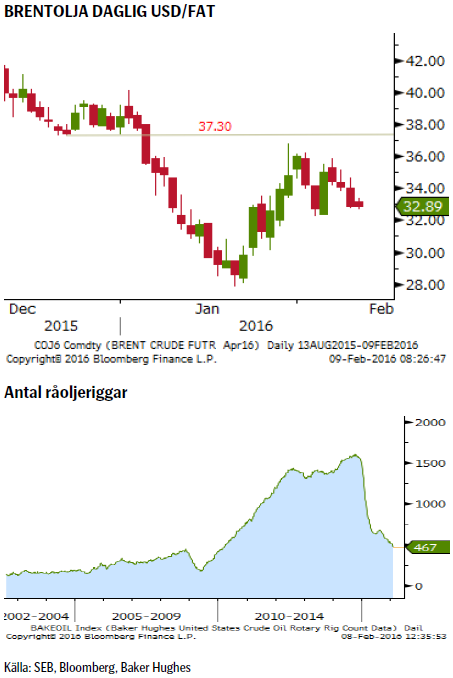 De större aktörerna i oljemarknaden betraktar fortfarande uppgången som temporär och inte bestående. Vi tenderar att hålla med dem varför vi etiketterar årets uppgång som tillfällig. I och med det så är vår vy också att vi ska söka ett säljläge för Brentoljan. I det korta perspektivet, med en korrigerande dollar, är vi dock för närvarande osäkra på huruvida vi nått en korrektionstopp (troligen inte) eller ej. Optimalt är troligen att söka ett säljläge upp emot $37/fatsnivån.
De större aktörerna i oljemarknaden betraktar fortfarande uppgången som temporär och inte bestående. Vi tenderar att hålla med dem varför vi etiketterar årets uppgång som tillfällig. I och med det så är vår vy också att vi ska söka ett säljläge för Brentoljan. I det korta perspektivet, med en korrigerande dollar, är vi dock för närvarande osäkra på huruvida vi nått en korrektionstopp (troligen inte) eller ej. Optimalt är troligen att söka ett säljläge upp emot $37/fatsnivån.
TREND
- Överutbudet består.
- Iran påbörjar snart leveranser av ca 300,000 fat per dag till EU (Franska Total börjar ta leveranser om 160,000 fat per dag från 16:e februari). Detta lär bara vara början. Iran är i desperat behov av intäkter.
- Vare sig samtalen mellan OPEC och Ryssland eller söndagens intra OPEC träff mellan Saudi och Venezuela gav något resultat.
- Borriggarna fortsätter att ”falla” och har nu nått 1999 års nivå (dock är ju dagens riggar betydligt produktivare än de äldre så jämförelsen haltar dock något).
REKOMMENDATION
- BEAR OLJA X2 S om/när priset når $37/fat.
ZINK
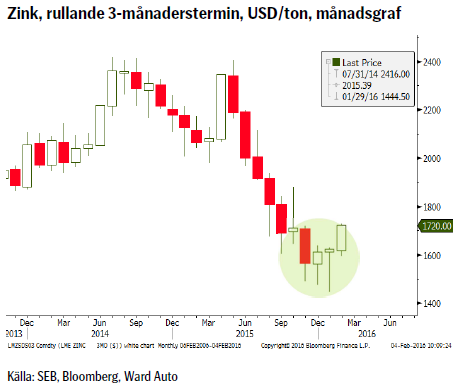 Zinkpriset har under de senaste två månaderna handlats på ett sätt (initialt ned under månaden men med högre månadsstängningar) som indikerar en möjlig långsiktigare botten. Ett förväntat marknadsunderskott på zink kan tillsammans med en omsvängning bland spekulanterna från kort till lång skapa en möjligt ”explosiv” uppgångsfas och speciellt så om US dollarn fortsätter att korrigera lägre.
Zinkpriset har under de senaste två månaderna handlats på ett sätt (initialt ned under månaden men med högre månadsstängningar) som indikerar en möjlig långsiktigare botten. Ett förväntat marknadsunderskott på zink kan tillsammans med en omsvängning bland spekulanterna från kort till lång skapa en möjligt ”explosiv” uppgångsfas och speciellt så om US dollarn fortsätter att korrigera lägre.
TREND
- Tecken på kraftigare korrektion eller t.o.m. trendvändning föreligger efter prisutvecklingen under december och januari (de långa spikarna på nedsidan indikerar ”besegrade” säljare).
- US-dollarn korrigerar lägre efter oväntat ”mjukt” tal från FED’s Dudley (räntehöjningen i mars ifrågasatt).
- Produktionen fortsätter att falla med både neddragningar såväl som gruvstängningar.
- Bilindustrin går starkt (lägre drivmedelspriser styr även kunderna mot allt större bilar).
- Säsongsmönstret är normalt positivt för februari och mars.
REKOMMENDATION
- BULL ZINK X4 s
GULD
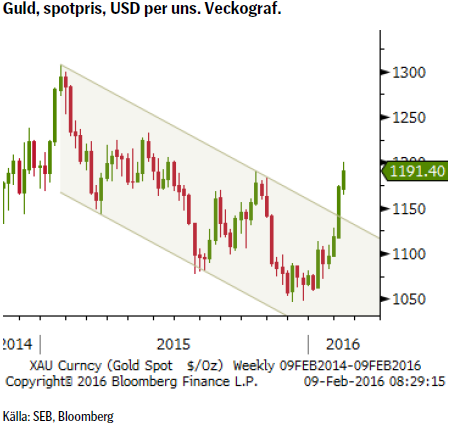 Guldet har gjort en storstilad comeback under början av 2016. Drivet av global riskaversion har guldet än en gång visat sig vara en relativt trygg hamn att ankra upp i. I och med att marknaden också börjar ifrågasätta både takten i FED’s räntehöjningar tog dollarn förra veckan en hel del stryk (och ytterligare dollar-försäljningar ser troliga ut i närtid när marknaden fortsätter att trimma ned sin fortfarande stora långa dollar position). Förra veckans Commitment of Traders rapport visar att den aggregerade långa dollar positionen föll med 15%.
Guldet har gjort en storstilad comeback under början av 2016. Drivet av global riskaversion har guldet än en gång visat sig vara en relativt trygg hamn att ankra upp i. I och med att marknaden också börjar ifrågasätta både takten i FED’s räntehöjningar tog dollarn förra veckan en hel del stryk (och ytterligare dollar-försäljningar ser troliga ut i närtid när marknaden fortsätter att trimma ned sin fortfarande stora långa dollar position). Förra veckans Commitment of Traders rapport visar att den aggregerade långa dollar positionen föll med 15%.
TREND
- Efter att marknaden misslyckats med hålla fast vidbrottet ned till nya lägstapriser under december noterar vi att marknaden i en accelererande fas verkar täcka sina korta positioner. Förra veckans uppgång var den största sedan början av 2015.
- Då de senaste årens mönster av fallande toppar och bottnar nu brutits och nedåtkanalen från början av 2015 lämnats bör vi kunna räkna med ytterligare uppgångar under våren mot $1300/1350 området.
- Den korrigerande dollarn förstärker för närvarande guldets uppgång.
- Kina’s centralbank (bland annat) fortsatte att även under januari att bygga upp sin guldreserv.
REKOMMENDATION
- Vi rekommenderar att köpa BULL GULD X2S samt att öka vid en guldrekyl ned mot $1150.
KAFFE
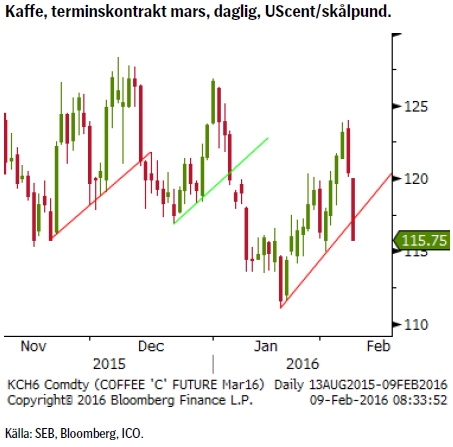 Exporten av kaffe är i ökande (+2.6% kvartal 4 2015 jämfört med 2014).
Exporten av kaffe är i ökande (+2.6% kvartal 4 2015 jämfört med 2014).
TREND
- Nedåttrenden är fortsatt obruten trots den senaste rekylen och den korta stödlinjen också vika igår.
- ICO, den internationella kaffeorganisationens senaste prognos pekar mot en ökad produktion för säsongen 2015/2016 jämfört med föregående säsong.
- Korrelationen mellan råolja och kaffe är relativt stark då petroleumprodukter är en viktig insatsvara i dagens jordbruk (till skillnad mot valutakurserna som har visat sig ha låga korrelationer med kaffe). Eftersom vi anser att oljans uppgång är temporär bör även kaffet fortsätta sin kräftgång.
REKOMMENDATION
- BEAR KAFFE X4 S (vi rekommenderar att öka på en bearposition vid brott under 114.95). Stopp om priset stiger över 124.
[box]SEB Veckobrev Veckans råvarukommentar är producerat av SEB:s Commodities Sales desk och publiceras i samarbete och med tillstånd på Råvarumarknaden.se[/box]
KÄLLOR
Bloomberg, Reuters, SEB
VILLKOR
För varje enskilt certifikat/mini future finns Slutliga Villkor som anger de fullständiga villkoren. Slutliga Villkor finns tillgängligt på kurssidan för respektive certifikat/mini future på www.seb.se, Börs & finans, fliken Strukturerade placeringar.
RISKER
En sammanfattning av de risker som är förknippade med Börshandlade certifikat generellt finns i Produktbroschyren för respektive certifikat eller mini future som är tillgängligt på seb.se/cert respektive seb.se/mini. För en fullständig bild av riskerna behöver du ta del av SEB:s offentliggjorda Grundprospekt för Certifikat- och Warrantprogram som är publicerat på www.seb.se/cert respektive seb.se/mini.
DISCLAIMER
Detta marknadsföringsmaterial, framtaget av SEB:s Commodities Sales desk, har upprättats enbart i informationssyfte.
Även om innehållet är baserat på källor som SEB bedömt som tillförlitliga ansvarar SEB inte för fel eller brister i informationen. Den utgör inte oberoende, objektiv investeringsanalys och skyddas därför inte av de bestämmelser som SEB har infört för att förebygga potentiella intressekonflikter. Yttranden från SEB:s Commodities Sales desk kan vara oförenliga med tidigare publicerat material från SEB, då den senare hänvisas uppmanas du att läsa den fullständiga rapporten innan någon åtgärd vidtas.
Dokumentationen utgör inte någon investeringsrådgivning och tillhandahålls till dig utan hänsyn till dina investeringsmål. Du uppmanas att självständigt bedöma och komplettera uppgifterna i denna dokumentation och att basera dina investeringsbeslut på material som bedöms erforderligt. Alla framåtblickande uttalanden, åsikter och förväntningar är föremål för risker, osäkerheter och andra faktorer och kan orsaka att det faktiska resultatet avviker väsentligt från det förväntade. Historisk avkastning är ingen garanti för framtida resultat. Detta dokument utgör inte ett erbjudande att teckna några värdepapper eller andra finansiella instrument. SEB svarar inte för förlust eller skada – direkt eller indirekt, eller av vad slag det vara må – som kan uppkomma till följd av användandet av detta material eller dess innehåll.
Observera att det kan förekomma att SEB, dess ledamöter, dess anställda eller dess moder- och/eller dotterbolag vid olika tillfällen innehar, har innehaft eller kommer att inneha aktier, positioner, rådgivningsuppdrag i samband med corporate finance-transaktioner, investment- eller merchantbanking-uppdrag och/eller lån i de bolag/finansiella instrument som nämns i materialet.
Materialet är avsett för mottagaren, all spridning, distribuering mångfaldigande eller annan användning av detta meddelande får inte ske utan SEB:s medgivande. Materialet riktar sig inte till personer vars medverkan kräver ytterligare prospekt, registrerings- eller andra åtgärder än vad som följer av svensk rätt. Det åligger var och en att iaktta sådana restriktioner. Materialet får inte distribueras i eller till land där distribution kräver ovan nämnda åtgärder eller strider mot reglering i sådant land. Materialet riktar sig således inte till fysiska eller juridiska personer hemmahörande i USA eller i något annat land där publicering eller tillhandahållande av materialet är förbjudet eller strider mot tillämpliga bestämmelser i landet.
Oaktat detta får SEB tillåta omfördelning av materialet till utvald tredje part i enlighet med gällande avtal. Materialet får inte spridas till fysiska eller juridiska personer som är medborgare eller har hemvist i ett land där sådan spridning är otillåten enligt tillämplig lag eller annan bestämmelse.
Skandinaviska Enskilda Banken AB (publ) är ett publikt aktiebolag och står under tillsyn av Finansinspektionen samt de lokala finansiella tillsynsmyndigheter i varje jurisdiktionen där SEB har filial eller dotterbolag.
Analys
Brace for Covert Conflict

In the past two trading days, Brent Crude prices have fluctuated between highs of USD 92.2 per barrel and lows of USD 88.7 per barrel. Despite escalation tensions in the Middle East, oil prices have remained relatively stable over the past 24 hours. The recent barrage of rockets and drones in the region hasn’t significantly affected market sentiment regarding potential disruptions to oil supply. The key concern now is how Israel will respond: will it choose a strong retaliation to assert deterrence, risking wider regional instability, or will it revert to targeted strikes on Iran’s proxies in Lebanon, Syria, Yemen, and Iraq? While it’s too early to predict, one thing is clear: brace for increased volatility, uncertainty, and speculation.

Amidst these developments, the market continues to focus on current fundamentals rather than unfolding geopolitical risks. Despite Iran’s recent attack on Israel, oil prices have slid, reflecting a sideways or slightly bearish sentiment. This morning, oil prices stand at USD 90 per barrel, down 2.5% from Friday’s highs.
The attack
Iran’s launch of over 300 rockets and drones toward Israel marks the first direct assault from Iranian territory since 1991. However, the attack, announced well in advance, resulted in minimal damage as Israeli and allied forces intercepted nearly all projectiles. Hence, the damage inflicted was limited. The incident has prompted US President Joe Biden to urge Israel to exercise restraint, as part of broader efforts to de-escalate tensions in the Middle East.
Israel’s response remains uncertain as its war cabinet deliberates on potential courses of action. While the necessity of a response is acknowledged, the timing and magnitude remain undecided.
The attack was allegedly in retaliation for an Israeli airstrike on Iran’s consulate in Damascus, resulting in significant casualties, including a senior leader in the Islamic Revolutionary Guard Corps’ elite Quds Force. It’s notable that this marks the first direct targeting of Israel from Iranian territory, setting the stage for heightened tensions between the two nations.
Despite the scale of the attack, the vast majority of Iranian projectiles were intercepted before reaching Israeli territory. However, a small number did land, causing minor damage to a military base in the southern region.
President Biden swiftly condemned Iran’s actions and pledged to coordinate a diplomatic response with leaders from the G7 nations. The US military’s rapid repositioning of assets in the region underscores the seriousness of the situation.
Iran’s willingness to escalate tensions further depends on Israel’s response, as indicated by General Mohammad Bagheri, chief of staff of the Iranian armed forces. Meanwhile, speculation about a retaliatory attack from Israel persists.
Looking ahead, key questions remain unanswered. Will Iran launch additional attacks? How will Israel respond, and what implications will it have for the region? Moreover, how will Iran’s allies react to the escalating tensions?
Given the potential for a full-scale war between Iran and Israel, concerns about its impact on global energy markets are growing. Both the United States and China have strong incentives to reduce tensions in the region, given the destabilizing effects of a regional conflict.
Our view in conclusion
The recent escalation between Iran and Israel underscores the delicate balance of power in the volatile Middle East. With tensions reaching unprecedented levels and the specter of further escalation looming, the potential for a full-blown conflict cannot be understated. The ramifications of such a scenario would be far-reaching and could have significant implications for regional stability and global security.
Turning to the oil market, there has been much speculation about the possibility of a full-scale blockade of the Strait of Hormuz in the event of further escalation. However, at present, such a scenario remains highly speculative. Nonetheless, it is crucial to note that Iran’s oil production and exports remain at risk even without further escalation. Currently producing close to 3.2 million barrels per day, Iran has significantly increased its production from mid-2020 levels of 1.9 million barrels per day.
In response to the recent attack, Israel may exert pressure on its ally, the US, to impose stricter sanctions on Iran. The enforcement of such sanctions, particularly on Iranian oil exports, could result in a loss of anywhere between 0.5 million to 1 million barrels per day of oil supply. This would likely keep the oil market in deficit for the remainder of the year, contradicting the Biden administration’s wish to maintain oil and gasoline prices at sustainable levels ahead of the election. While other OPEC nations have spare capacity, utilizing it would tighten the global oil market even further. Saudi Arabia and the UAE, for example, could collectively produce an additional almost 3 million barrels of oil per day if necessary.
Furthermore, both Iran and the US have expressed a desire to prevent further escalation. However, much depends on Israel’s response to the recent barrage of rockets. While Israel has historically refrained from responding violently to attacks (1991), the situation remains fluid. If Israel chooses not to respond forcefully, the US may be compelled to promise stronger enforcement of sanctions on Iranian oil exports. Consequently, Iranian oil exports are at risk, regardless of whether a wider confrontation ensues in the Middle East.
Analyzing the potential impact, approximately 2.2 million barrels per day of net Iranian crude and condensate exports could be at risk, factoring in Iranian domestic demand and condensate production. The effectiveness of US sanctions enforcement, however, remains uncertain, especially considering China’s stance on Iranian oil imports.
Despite these uncertainties, the market outlook remains cautiously optimistic for now, with Brent Crude expected to hover around the USD 90 per barrel mark in the near term. Navigating through geopolitical tensions and fundamental factors, the oil market continues to adapt to evolving conflicts in the Middle East and beyond.
Analys
OPEC+ won’t kill the goose that lays the golden egg

Lots of talk about an increasingly tight oil market. And yes, the oil price will move higher as a result of this and most likely move towards USD 100/b. Tensions and flareups in the Middle East is little threat to oil supply and will be more like catalysts driving the oil price higher on the back of a fundamentally bullish market. I.e. flareups will be more like releasing factors. But OPEC+ will for sure produce more if needed as it has no interest in killing the goose (global economy) that lays the golden egg (oil demand growth). We’ll probably get verbal intervention by OPEC+ with ”.. more supply in H2” quite quickly when oil price moves closer to USD 100/b and that will likely subdue the bullishness. OPEC+ in full control of the oil market probably means an oil price ranging from USD 70/b to USD 100/b with an average of around USD 85/b. Just like last year.

Brent crude continues to trade around USD 90/b awaiting catalysts like further inventory declines or Mid East flareups. Brent crude ydy traded in a range of USD 88.78 – 91.1/b before settling at USD 90.38/b. Trading activity ydy seems like it was much about getting comfortable with 90-level. Is it too high? Is there still more upside etc. But in the end it settled above the 90-line. This morning it has traded consistently above the line without making any kind of great leap higher.
Netanyahu made it clear that Rafah will be attacked. Israel ydy pulled some troops out of Khan Younis in Gaza and that calmed nerves in the region a tiny bit. But it seems to be all about tactical preparations rather than an indication of a defuse of the situation. Ydy evening Benjamin Netanyahu in Israel made it clear that a date for an assault on Rafah indeed has been set despite Biden’s efforts to prevent him doing so. Article in FT on this today. So tension in Israel/Gaza looks set to rise in not too long. The market is also still awaiting Iran’s response to the bombing of its consulate in Damascus one week ago. There is of course no oil production in Israel/Gaza and not much in Syria, Lebanon or Yemen either. The effects on the oil market from tensions and flareups in these countries are first and foremost that they work as catalysts for the oil price to move higher in an oil market which is fundamentally bullish. Deficit and falling oil inventories is the fundamental reason for why the oil price is moving higher and for why it is at USD 90/b today. There is also the long connecting string of:
[Iran-Iraq-Syria/Yemen/Lebanon/Gaza – Israel – US]
which creates a remote risk that oil supply in the Middle East potentially could be at risk in the end when turmoil is flaring in the middle of this connecting string. This always creates discomfort in the oil market. But we see little risk premium for a scenario where oil supply is really hurt in the end as neither Iran nor the US wants to end up in such a situation.
Tight market but OPEC+ will for sure produce more if needed to prevent global economy getting hurt. There is increasing talk about the oil market getting very tight in H2-24 and that the oil price could shoot higher unless OPEC+ is producing more. But of course OPEC+ will indeed produce more. The health of the global economy is essential for OPEC+. Healthy oil demand growth is like the goose that lays the golden egg for them. In no way do they want to kill it with too high oil prices. Brent crude averaged USD 82.2/b last year with a high of USD 98/b. So far this year it has averaged USD 82.6/b. SEB’s forecast is USD 85/b for the average year with a high of USD 100/b. We think that a repetition of last year with respect to oil prices is great for OPEC+ and fully acceptable for the global economy and thus will not hinder a solid oil demand growth which OPEC+ needs. Nothing would make OPEC+ more happy than to produce at a normal level and still being able to get USD 85/b. Brent crude will head yet higher because OPEC+ continues to hold back supply Q2-24 resulting in declining inventories and thus higher prices. But when the oil price is nearing USD 100/b we expect verbal intervention from the group with statements like ”… more supply in H2-24” and that will probably dampen bullish prices.
Not only does OPEC+ want to produce at a normal level. It also needs to produce at a normal level. Because at some point in time in the future there will be a situation sooner or later where they will have to cut again. And unless they are back to normal production at that time they won’t be in a position to cut again.
So OPEC+ won’t kill the goose that lays the golden egg. They won’t allow the oil price to stay too high for too long. I.e. USD 100/b or higher. They will produce more in H2-24 if needed to prevent too high oil prices and they have the reserve capacity to do it.
Data today: US monthly oil market report (STEO) with forecast for US crude and liquids production at 18:00 CET
Analys
Prepare for more turmoil, lower inventories and higher prices

Brent crude is pulling back below the 90-line this morning trading as low as USD 88.78/b following a 4.2% gain last week. The pullback is blamed on news that Israel is pulling some troops out of Gaza. But we think this is much more of a technical move below the 90-line with preparations for further price gains ahead. The Israeli troop movements are a preparation for a final push into Rafah in Gaza to take out the last stronghold of Hamas there (FT article today). Iranian retaliation following the attack in Damascus last week also looks set to unfold in some way. Possibly by Hezbollah in Lebanon though instigated by Iran. Prepare for more turmoil, lower oil inventories and higher prices as the market continues to run a deficit.

Brent gained 4.2% last week with a solid close above the 90-line. Brent crude had a stellar week last week gaining 4.2%. Even following such a strong performance it made a gain on Friday of 0.6% with a close at USD 91.17/b. Friday also saw the highest trade of the week at USD 91.91/b.
Brent was propelled by positive PMI gains, geopolitics and falling US inventories. Oil was supported by a rang of factors last week. Both the US and China saw their manufacturing PMIs rise above the 50-line (50.3 and 50.8 resp.). The Eurozone manufacturing PMI rose to 46.1 from 45.7 while the composite index rose above the 50-line to 50.3 from 49.9. These PMI gains supported both oil and metals through growth recovery optimism. US oil inventories last Wednesday created less waves with a net draw of 2.2 m b in total crude and product inventories. It was still a very bullish reading in our view as inventories normally this time of year should have risen 3.8 m b. Thus driving US commercial oil inventories further away and below the normal level of inventories. Geopolitical focus flared up following the attack on Iran’s consulate in Syria where Iran’s top Islamic Revolutionary Guard Corps (IRGC) general in Syria along with five other IRGC officers were killed. Israel is assumed to be behind the attack but has not taken responsibility yet.
Back below 90 this morning in what seems like a geopolitical breather. But is more of a technical move. This morning Brent crude has pulled back and traded as low as USD 88.78/b while trading at USD 89.76/b. We commented on Friday that it is quite normal for Brent crude to pull back below big numbers after having broken them. Just to test out the level properly before heading higher.
Israel is pulling some troops out of Gaza. Most likely it is preparing to attack Rafah (FT today). Price action to the downside this morning is blamed on some kind of reduced geopolitical premium as Israel is withdrawing some of its troops in Gaza. The reason why it is withdrawing some tropes however is to our understanding that Israel is preparing to attack Rafah, the southernmost part of Gaza bordering to Egypt where now close to one million Palestinians are living. It is the last strong-hold of Hamas and Israel looks bent on taking it out despite repeated warnings against it from the US. Human tragedy looks set to unfold in Rafah in not too long.
”Iran will respond to the Damascus strike”. The most likely flareup is Lebanon and Hezbollah. The geopolitical flare following the attack on Iran’s consulate in Syria last week has faded a little this morning. But this is in no way over. John Sawers, former chief of MI6, in an article in FT on Friday bluntly stated: ”Iran will respond to the Damascus strike”. Iran still doesn’t want to be involved in direct military confrontation. The likely flareup will be Lebanon and Hezbollah which could force Israel into a two-front war.
Rafah is located in the southernmost part of Gaza
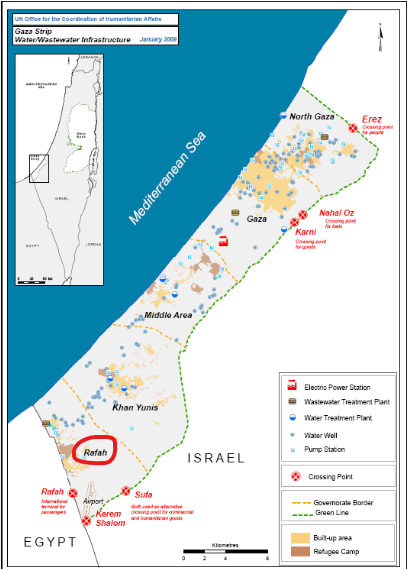
Net long specs in Brent + WTI rose by 34 m b over the week to 2 April.
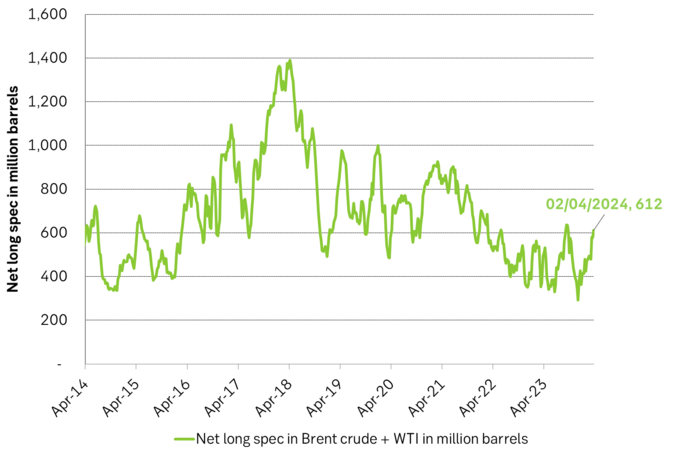
Saudi Arabia lifted its Official Selling Prices to Asia for most grades for May delivery
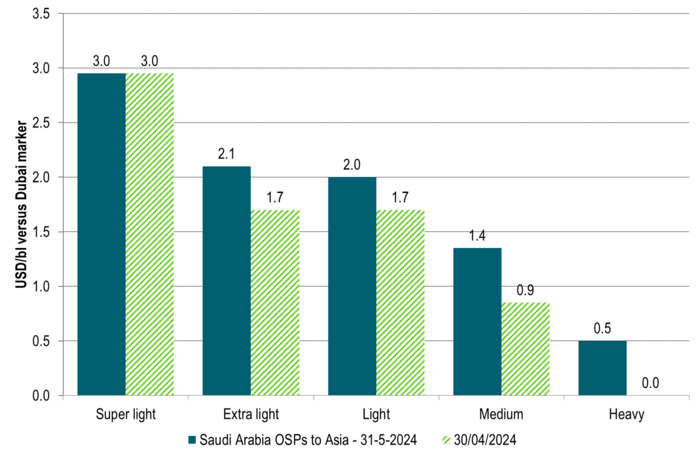
-

 Nyheter4 veckor sedan
Nyheter4 veckor sedanMichel Rufli om trenderna som får guldpriset att stiga
-

 Nyheter4 veckor sedan
Nyheter4 veckor sedanGuld toppar 2200 USD per uns
-

 Nyheter3 veckor sedan
Nyheter3 veckor sedanVertikal prisuppgång på kakao – priset toppar nu 9000 USD
-

 Nyheter3 veckor sedan
Nyheter3 veckor sedanLundin Mining får köprekommendation av BMO
-

 Nyheter2 veckor sedan
Nyheter2 veckor sedanGuldpriset når nytt all time high och bryter igenom 2300 USD
-

 Nyheter2 veckor sedan
Nyheter2 veckor sedanCentralbanker fortsatte att köpa guld under februari
-

 Nyheter3 veckor sedan
Nyheter3 veckor sedanKaffepriserna stiger på lågt utbud och stark efterfrågan
-

 Nyheter2 veckor sedan
Nyheter2 veckor sedanHur mår den svenska skogsbraschen? Två favoritaktier








